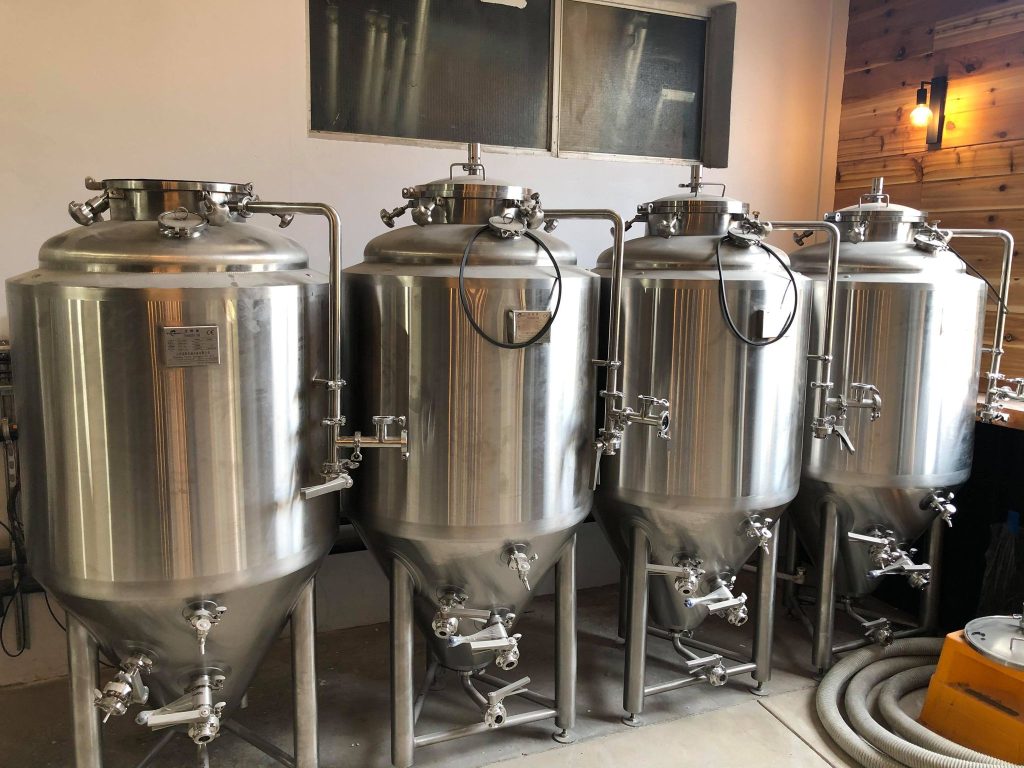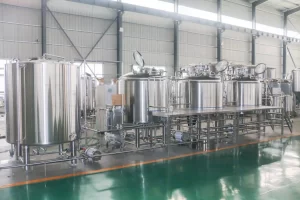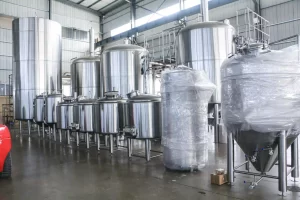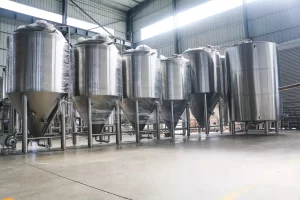Aufstockung: Gärtanks für kommerzielle Brauereien

Mit dem Wachstum Ihrer Brauerei wächst auch der Bedarf an hochwertiger Ausrüstung, um Effizienz und Konsistenz zu gewährleisten. Gärtanks sind eine entscheidende Komponente bei der Ausweitung des Brauereibetriebs. Die Wahl der richtigen Gärtanks kann sich auf die Qualität Ihres Biers, die Produktionsgeschwindigkeit und den allgemeinen Geschäftserfolg auswirken. In diesem Artikel gehen wir auf die wichtigsten Faktoren ein, die bei der Auswahl von Gärtanks für gewerbliche Brauereien zu beachten sind.
1. Die Rolle von Gärbehältern beim Brauen
In den Gärtanks findet die Magie statt. Nach dem Brauen wird die Würze in den Gärtank geleitet, wo die Hefe den Zucker in Alkohol und Kohlendioxid umwandelt. Dieser Prozess beeinflusst den Geschmack, die Klarheit und die Stabilität des Bieres. In einer kommerziellen Brauerei ist es wichtig, Gärtanks zu wählen, die eine präzise Steuerung der Temperatur und der Bedingungen ermöglichen, um gleichbleibend hochwertiges Bier in großem Maßstab zu produzieren.
2. Arten von Gärbehältern für gewerbliche Brauereien
Es gibt verschiedene Arten von Gärtanks, die je nach Brauprozess und Bierstil in Frage kommen. Die beiden gängigsten Typen sind:
- Konische Gärungstanks: Diese Tanks sind in der gewerblichen Brauerei weit verbreitet. Ihre konische Form ermöglicht ein effizientes Auffangen der Hefe, was die Ernte oder Wiederverwendung der Hefe erleichtert. Das Design hilft auch bei der Entfernung von Sedimenten und verbessert die Klarheit des Bieres. Konische Tanks eignen sich sowohl für die Hauptgärung als auch für die Konditionierung, was sie ideal für Großbetriebe macht.
- Zylindrische Gärbehälter: Sie werden in der Regel für die Lagerung oder Gärung größerer Biermengen verwendet. Ihre zylindrische Form bietet reichlich Platz für die Gärung und eine präzise Temperaturkontrolle. Zylindrische Tanks werden häufig für das Brauen großer Biermengen verwendet und sind ideal für Brauereien, die Lagerbiere herstellen, die längere Gärungszeiten benötigen.
3. Tankgröße und Kapazität
Wenn Ihre Brauerei wächst, wächst auch Ihr Bedarf an Gärung. Gewerbliche Brauereien benötigen oft Gärtanks mit größerem Fassungsvermögen, das von 7 Fässern bis zu 100+ Fässern reicht. Berücksichtigen Sie bei der Wahl der richtigen Größe das aktuelle Produktionsvolumen Ihrer Brauerei und das zukünftige Wachstum. Es ist wichtig, dass die Tanks genügend Platz haben, um die Nachfrage zu decken, ohne die Brauereikapazität zu überlasten.
Kleinere Brauereien beginnen vielleicht mit Tanks von 7-15 Fässern, aber größere Betriebe benötigen möglicherweise Tanks im Bereich von 30-50 Fässern. Wenn Sie in der Zukunft mit einer Vergrößerung rechnen, können Sie durch die Investition in größere Gärtanks spätere kostspielige Nachrüstungen vermeiden.
4. Material und Langlebigkeit
Gärtanks für gewerbliche Brauereien werden in der Regel aus Edelstahl hergestellt. Edelstahl ist langlebig, korrosionsbeständig und leicht zu reinigen, was für die Einhaltung hoher Hygienestandards unerlässlich ist. Edelstahl in Lebensmittelqualität (304 oder 316) wird für alle Gärtanks empfohlen, da er die beste Qualität und Sicherheit für die Bierherstellung gewährleistet.
Langlebigkeit ist in der gewerblichen Brauerei der Schlüssel zum Erfolg, da die Gärtanks ständig im Einsatz sind. Ein hochwertiger Edelstahltank ist verschleißfest und kann langfristig eingesetzt werden, ohne dass der Geschmack oder die Integrität des Biers beeinträchtigt werden.
5. Merkmale der Temperaturregelung
Einer der wichtigsten Aspekte der Gärung ist die Temperaturkontrolle. Hefe verhält sich bei verschiedenen Temperaturen unterschiedlich, was sich direkt auf das Endprodukt auswirkt. Für eine gleichbleibende Bierqualität ist die Temperaturkontrolle unerlässlich.
Kommerzielle Gärtanks verfügen häufig über eingebaute Kühlmäntel oder Glykolleitungen, die es ermöglichen, eine konstante Gärtemperatur aufrechtzuerhalten. Je nach Art des hergestellten Biers kann die Temperaturregelung zwischen 45°F für Lagerbiere und 65°F oder höher für Biere liegen. Tanks mit automatischer Temperaturregelung verringern das Risiko von Gärungsproblemen und gewährleisten optimale Ergebnisse.
6. Leichte Reinigung und Wartung
In einer gewerblichen Brauerei sind Effizienz und Hygiene von größter Bedeutung. Gärtanks sollten leicht zu reinigen und zu warten sein. Tanks, die mit CIP-Systemen (Clean-in-Place) ausgestattet sind, eignen sich ideal für gewerbliche Brauereien, da sie eine schnelle und gründliche Reinigung ermöglichen, ohne dass die Ausrüstung demontiert werden muss.
Achten Sie außerdem auf Gärtanks mit Zugangsluken oder Schächten. Diese Merkmale erleichtern die Inspektion und Reinigung des Innenraums und verringern die Wahrscheinlichkeit von Verunreinigungen oder Bakterienansammlungen, die Ihr Bier verderben könnten.
7. Kosten und ROI
Die Investition in einen Gärtank ist eine wichtige Entscheidung für jede gewerbliche Brauerei. Auch wenn es wichtig ist, das Budget einzuhalten, sollte die Qualität im Vordergrund stehen. Ein hochwertiger Gärtank trägt nicht nur zur Herstellung von besserem Bier bei, sondern verbessert auch die Effizienz des Brauprozesses.
Berücksichtigen Sie die langfristige Investitionsrendite (ROI). Qualitativ hochwertigere Tanks haben zwar höhere Anschaffungskosten, sparen aber Geld für Wartung, Reparaturen und potenzielle Probleme bei der Qualitätskontrolle. Es ist auch wichtig, die Betriebskosten, wie Energieverbrauch und Wartung, zu berücksichtigen.
8. Die Wahl des richtigen Lieferanten
Beim Kauf von Gärtanks ist es wichtig, mit einem seriösen Anbieter zusammenzuarbeiten, der die Bedürfnisse gewerblicher Brauereien kennt. Suchen Sie nach Anbietern, die über Erfahrung in der Brauindustrie verfügen und in der Vergangenheit hochwertige Anlagen geliefert haben. Ein zuverlässiger Lieferant kann Sie bei der Auswahl der Tanks, der Installation und der laufenden Betreuung beraten, um den Erfolg Ihrer Brauerei zu gewährleisten.
Vergewissern Sie sich, dass der Lieferant Garantien und Kundendienst bietet, um Ihre Investition zu schützen. Eine gute Beziehung zu Ihrem Lieferanten kann zu besseren Angeboten und schnelleren Lösungen bei Problemen mit der Ausrüstung führen.
Schlussfolgerung
Die Wahl des richtigen Gärtanks ist eine wichtige Entscheidung, wenn Sie Ihre gewerbliche Brauerei vergrößern wollen. Mit den richtigen Tanks können Sie die Bierqualität verbessern, die Produktionseffizienz steigern und die wachsende Nachfrage befriedigen. Wenn Sie Faktoren wie Tankart, Größe, Material, Temperaturregelung und Wartungsfreundlichkeit berücksichtigen, können Sie die idealen Gärtanks für die Anforderungen Ihrer Brauerei finden.
Die Investition in qualitativ hochwertige Gärtanks wird sich langfristig auszahlen, da sie das Wachstum Ihrer Brauerei unterstützt und die Konsistenz und Qualität Ihres Bieres gewährleistet. Die Zusammenarbeit mit einem zuverlässigen Lieferanten wird Ihnen helfen, allen Herausforderungen voraus zu sein und sicherzustellen, dass Ihre Brauerei weiterhin erfolgreich ist.
Die wichtigsten Erkenntnisse:
- Wählen Sie je nach Brauprozess zwischen konischen und zylindrischen Gärtanks.
- Wählen Sie eine Tankgröße, die Ihrem aktuellen und zukünftigen Produktionsbedarf entspricht.
- Legen Sie Wert auf Temperaturkontrolle, Materialqualität und Wartungsfreundlichkeit.
- Arbeiten Sie mit einem vertrauenswürdigen Anbieter zusammen, um fachkundige Beratung und Unterstützung zu erhalten.
Wenn Sie diese Schritte befolgen, können Sie Ihre Brauerei mit den richtigen Gärtanks für eine gleichbleibend hochwertige Bierproduktion erfolgreich erweitern.
https://www.tcbrewbeer.com/en/1000l-fermentation-tank/
https://www.tcbrewbeer.com/en/7bbl-fermentation-tank/
https://www.tcbrewbeer.com/en/80bbl-fermentation-tank/
https://www.tonsenbrewing.com/products-fermenting-system-for-beer-brew.html
Verwandte Empfehlungen
Wie Sie die Brauereiplanung meistern: Berechnen Sie die ideale Brauereigröße für Ihr Craft Beer Geschäft
885Erfahren Sie, wie Sie die ideale Brauereigröße für Ihr Craft-Bier-Unternehmen berechnen können, und erhalten Sie Tipps von Experten zur Brauereiplanung, zum Platzbedarf für die Ausrüstung und zu effizienten Layouts.
Details anzeigenWie man eine Mikrobrauerei baut: Eine Schritt-für-Schritt-Anleitung zur Herstellung Ihres eigenen Gebräus
823Erfahren Sie, wie Sie eine Kleinbrauerei gründen können, und erhalten Sie Tipps zu Ausrüstung, Rezepten und Marketing, um Ihr eigenes Bierunternehmen erfolgreich zu starten.
Details anzeigenBusinessplan für die Gründung einer Brauerei: Ihr ultimativer Leitfaden für den Erfolg einer Brauerei
981Geschäftsplan für die Gründung einer Brauerei
Details anzeigenNeue Anfänge mit professionellen Brauereianlagen
1222Verbessern Sie Ihr Bierbrauen mit professioneller Brauereiausrüstung. Entdecken Sie innovative, nachhaltige Lösungen für die Herstellung von außergewöhnlichem Bier im Jahr 2025.
Details anzeigen
 Shandong Tonsenbrew Co., Ltd.
Shandong Tonsenbrew Co., Ltd.





HalloBitte melden Sie sich an